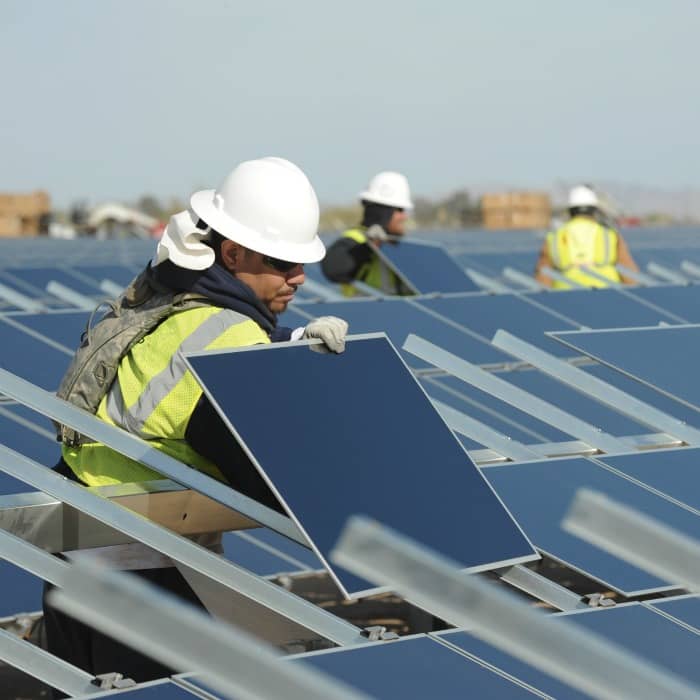 The installed price of solar photovoltaic power systems in the U.S. fell substantially in 2011 and through the first half of 2012, according to the latest edition of Tracking the Sun, an annual PV cost-tracking report produced by the Department of Energy's Lawrence Berkeley National Laboratory (Berkeley Lab).
The installed price of solar photovoltaic power systems in the U.S. fell substantially in 2011 and through the first half of 2012, according to the latest edition of Tracking the Sun, an annual PV cost-tracking report produced by the Department of Energy's Lawrence Berkeley National Laboratory (Berkeley Lab).
The median installed price of residential and commercial PV systems completed in 2011 fell by roughly 11% to 14% from the year before, depending on system size. In California, prices fell by an additional 3% to 7% within the first six months of 2012.
These recent installed price reductions are attributable, in large part, to dramatic reductions in PV module prices, which have been falling precipitously since 2008, according to Berkeley Lab.
The report indicates that non-module costs – such as installation labor, marketing, overhead, inverters and the balance of system – have also fallen significantly over time.Â
‘The drop in non-module costs is especially important, as these costs can be most readily influenced by local, state and national policies aimed at accelerating deployment and removing market barriers,’ notes report co-author Ryan Wiser of Berkeley Lab's Environmental Energy Technologies Division.
According to the report, average non-module costs for residential and commercial systems declined by roughly 30% from 1998 to 2011, but they have not declined as rapidly as module prices in recent years. As a result, non-module costs now represent a sizable fraction of the installed price of PV systems, and continued deep reduction in the price of PV will require concerted emphasis on lowering the portion of non-module costs associated with business-process or soft costs.
The report indicates that the median installed price of PV systems installed in 2011 was $6.10/W for residential and small commercial systems smaller than 10 kW in size and was $4.90/W for larger commercial systems of 100 kW or more in size.
Utility-sector PV systems larger than 2,000 kW in size averaged $3.40/W in 2011. Report co-author Galen Barbose, also of Berkeley Lab, stresses the importance of keeping these numbers in context.
‘These data provide a reliable benchmark for systems installed in the recent past, but prices have continued to decline over time, and PV systems being sold today are being offered at lower prices,’ Barbose says.
Based on these data and on installed price data from other major international PV markets, the authors suggest that PV prices in the U.S. may be driven lower through large-scale deployment programs, but that other factors are also important in achieving installed price reductions.
The market for solar PV systems in the U.S. has grown rapidly over the past decade, as national, state and local governments offered various incentives to expand the solar market and accelerate cost reductions.
Regional differences
The study also highlights the significant variability in PV system pricing – some of which is associated with differences in installed prices by region and by system size and installation type. Across U.S. states, for example, the median installed price of PV systems less than 10 kW in size that were completed in 2011 ranged from $4.90/W to $7.60/W, depending on the state.
It also shows that PV installed prices exhibit significant economies of scale. Among systems installed in 2011, the median price for systems smaller than 2 kW was $7.70/W, while the median price for large commercial systems greater than 1,000 kW in size was $4.50/W. Utility-scale systems installed in 2011 registered even lower prices, with most systems larger than 10,000 kW ranging from $2.80/W to $3.50/W.
The report also finds that the installed price of residential PV systems on new homes has generally been significantly lower than the price of similarly sized systems installed as retrofits to existing homes, that building integrated PV systems have generally been higher priced than rack-mounted systems, and that systems installed on tax-exempt customer sites have generally been priced higher than those installed at residential and for-profit commercial customer sites.
State agencies and utilities in many regions offer rebates or other forms of cash incentives for residential and commercial PV systems. According to the report, the median pre-tax value of such cash incentives ranged from $0.90/W to $1.20/W for systems installed in 2011, depending on system size. These incentives have declined significantly over time, falling by roughly 80% over the past decade, and by 21% to 43% from just 2010 to 2011.Â
Rather than a direct cash incentive, some states with renewable portfolio standards provide financial incentives for solar PV by creating a market for solar renewable energy certificates (SRECs), and SREC prices have also fallen dramatically in recent years, the report notes. These declines in cash incentives and SREC prices have, to a significant degree, offset recent installed price reductions, dampening any overall improvement in the customer economics of solar PV.
The full report can be downloaded here.
Photo credit: First Solar

